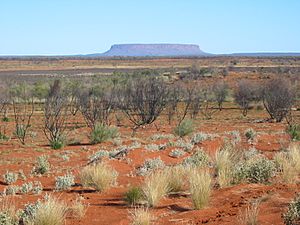Mount Conner facts for kids
Quick facts for kids Mount Conner |
|
|---|---|
| Atila (Yankunytjatjara) | |

Mount Conner seen from the road to Uluru
|
|
| Highest point | |
| Elevation | 859 m (2,818 ft) |
| Prominence | 300 m (980 ft) |
| Geography | |
|
Lua error in Module:Location_map at line 420: attempt to index field 'wikibase' (a nil value).
|
|
| Geology | |
| Mountain type | inselberg |
Mount Conner, also known as Atila, is a large mountain in the middle of Australia. You can find it in the southwest part of the Northern Territory, about 75 kilometers (47 miles) southeast of Lake Amadeus. This mountain stands 859 meters (2,818 feet) above sea level and rises 300 meters (984 feet) from the flat land around it.
The mountain was named by William Gosse in 1873. He named it after Mountifort Longfield Conner, a politician from South Australia. You can often see Mount Conner from the road when you are driving towards Uluru from Alice Springs.
Mount Conner is a special type of mountain called an inselberg. This means it's a lone mountain that rises sharply from a flat plain. It has a flat top and looks a bit like a horseshoe. The rock it's made of is sedimentary rock. These rock layers were formed a very long time ago, between 1 billion and 542 million years ago. Back then, this whole area was covered by an ancient inland sea.
The rocks of Mount Conner are much older than the rocks of nearby Uluru and Kata Tjuta. They are 200 to 300 million years older! Over millions of years, the younger layers of sedimentary rock wore away. This left behind the unique inselberg we see today.
In the native Yankunytjatjara and Pitjantjatjara languages, the mountain is called Atila. Sometimes it's spelled Artila, Atula, Attila, or Artilla. The land around it is known as Atilanya. This area is important in Tjukurpa (Dreaming) stories. These stories are about the nyiṉya, which means "ice people." The nyiṉya are ancestral spirits who are believed to bring cold weather.
Contents
History and Traditional Stories
For the native Yankunytjatjara people, Mount Conner has long been connected to the Wanambi Dreaming. Wanambi is an ancestral spirit believed to live in the springs in and around the mountain.
Legends of the Wanambi Spirit
Stories about the Wanambi Dreaming were written down by Charles P. Mountford. He visited the area in 1940. He wrote that a very dangerous Wanambi spirit was said to live in Kapi Atila. This was a spring that used to be halfway up the southern side of the mountain. When the spring dried up, the people of Atilanya believed that the wanambi was stolen. They thought people from the south took the spirit to their own land. This was so they would have more water there.
About 7 kilometers (4.3 miles) southwest of Mount Conner is another water source. It's a rock hole called Anari. In English, it's known as "Aneri Well" or "Mount Conner Well." Mountford camped there in 1940 on his way to Uluru. He recorded the name as "Anneri." He wrote that this was home to a harmless wanambi that had traveled north from the Musgrave Ranges. He also wrote about ceremonies related to the nyiṉya that women performed there.
The Legend of the Two Boys
Mountford also wrote down another legend about the mountain. It tells of a fight between two boys who were hunting in the area. According to the story, one boy accidentally found the spring at Anari. He refused to tell the other boy where he had found water. Because of this, the second boy almost died of thirst. They fought each other and slowly made their way to the top of the mountain. There, they both died. Their bodies are said to be preserved as boulders on the mountain.
Anari was once the site of the first homestead for Mount Conner Station. This old homestead is now empty. The new homestead is located further north, on the Lasseter Highway. A dirt track leads from there to the base of Mount Conner.
Geology and Rock Formations
Mount Conner is made up of different types of rocks. These include conglomerates, sandstones, siltstones, and mudstones. The very top of the mountain, called the summit, has coarse-grained sandstone. This sandstone contains layers of small pebbles and thin beds of pebble conglomerate and siltstone.
Layers of Rock
The rock found just below the summit is made of dark brown micaceous siltstone, mudstone, and fine-grained sandstone. The lower part of the mountain has medium to coarse-grained, grey-brown sandstones, dark-brown siltstones, and cherts. The sides of Mount Conner are also covered by scree (loose rocks that have fallen). Its top is covered with colluvium (loose soil and rock fragments). The base of the mountain is surrounded by alluvium (sediment deposited by water).
The summits of Mount Conner, along with Kata Tjuṯa and Uluru, are what's left after a layer of sediment from the Cretaceous period wore away. Mount Conner is a great example of an inselberg. It was created when the softer rock layers around it eroded over time, leaving the harder mountain standing tall.
Images for kids



